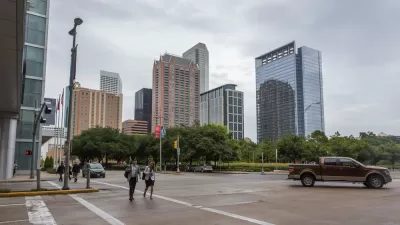Affordable housing providers have touted the connections between health and the places where people live for years. In a small city outside of Boston, the evidence is incontrovertible.

Maria Torres (name changed to protect individual’s identity) first moved to Chelsea, Massachusetts, several years ago. In the time since, Torres has learned English, developed her financial management and professional skills assisted by a financial coach at The Neighborhood Developers (TND), and independently prepared for and taken her citizenship test. However, her living conditions are still substandard. Torres, her husband, and their preteen daughter share a single room in a two-bedroom apartment; the other bedroom is occupied by Torres’s sister-in-law and her three-person family. Despite Torres’s hard-won successes, even this crowded standard of living is asking more of them financially than they can afford. Though they have so far been lucky enough to not contract COVID, with six people occupying a very small space, if the virus enters their home, there will be no way for them to protect themselves or each other.
Torres and her family are in an all-too-common situation. Located across the Mystic River from Boston, Chelsea is a small city, just 1.8 square miles. A majority of its 40,000 residents are Latinx; nearly 50 percent are foreign born. Chelsea prides itself on being highly community-oriented and has offered a warm welcome to generations of newcomers to the city and the country. TND has served this community for more than 40 years. Currently, TND has 1,175 residents in its affordable properties, and over 6,000 community members engage in programming each year.
Early on in the pandemic, Chelsea became a national hotspot for COVID-19. By early October, there were over 3,685 confirmed cases in Chelsea. Everyone in the city knows someone infected by COVID. Chelsea has by far the highest infection rate in the state, and one of the highest cumulative case rates in the nation.*
Many factors have contributed to the astronomical rate of infection in Chelsea. A large percentage of residents are considered essential workers who are unable to work from home. Underlying economic and environmental conditions have also played a role. Pre-COVID, in response to the rising costs of housing, many people were experiencing homelessness, or doubling up with other households or extended family and friends, like Torres’s family, often in just a one- or two-bedroom apartment. Many also reside in unhealthy living conditions such as unfinished basements, simply because there is no other option. With the loss of jobs and work hours since COVID hit, housing instability and overcrowding pressures have increased.
Unfortunately, overcrowding itself contributes to the rapid spread of the virus, as infected people come in contact with a larger household. In small overcrowded homes, when a family member falls ill, quarantining effectively is nearly impossible. Research compiled by the Donahue Center of UMass Boston documents that in Massachusetts, the three communities with the highest rates of crowding in homes—Chelsea, Lynn, and Lawrence—are also those in the state with the highest rates of COVID-19 infection.
Of Chelsea’s housing units, 10 percent are overcrowded, and as of Oct. 7, the city had a COVID-19 case rate of 918 per 10,000.
Lynn, with 7 percent overcrowding, had a 523 per 10,000 case rate, followed by Lawrence with 6 percent overcrowding and a 622 per 10,000 case rate.
Overcrowding is worse in immigrant communities and communities of color due to longstanding unjust economic and housing policies. Combined with pre-existing health inequities and higher rates of high-risk essential jobs, this has resulted in higher rates of COVID-19 exposure, infection, and death rates within Black, Indigenous, Latinx, and other communities of color.
However, this also means that we know one way to fight this and future pandemics: affordable housing.
Housing as a COVID-19 “Vaccine”
Six weeks into the COVID-19 crisis, TND realized that the residents of its properties in Chelsea were not falling ill at the same rate as the community at large.
...
FULL STORY: Residents of Nonprofit Housing Have Lower Rates of COVID

Alabama: Trump Terminates Settlements for Black Communities Harmed By Raw Sewage
Trump deemed the landmark civil rights agreement “illegal DEI and environmental justice policy.”

Planetizen Federal Action Tracker
A weekly monitor of how Trump’s orders and actions are impacting planners and planning in America.

The 120 Year Old Tiny Home Villages That Sheltered San Francisco’s Earthquake Refugees
More than a century ago, San Francisco mobilized to house thousands of residents displaced by the 1906 earthquake. Could their strategy offer a model for the present?

LA’s Tree Emergency Goes Beyond Vandalism
After a vandal destroyed dozens of downtown LA trees, Mayor Karen Bass vowed to replace them. Days later, she slashed the city’s tree budget.

Sacramento Leads Nation With Bus-Mounted Bike Lane Enforcement Cameras
The city is the first to use its bus-mounted traffic enforcement system to cite drivers who park or drive in bike lanes.

Seattle Voters Approve Social Housing Referendum
Voters approved a corporate tax to fund the city’s housing authority despite an opposition campaign funded by Amazon and Microsoft.
Urban Design for Planners 1: Software Tools
This six-course series explores essential urban design concepts using open source software and equips planners with the tools they need to participate fully in the urban design process.
Planning for Universal Design
Learn the tools for implementing Universal Design in planning regulations.
Ada County Highway District
Clanton & Associates, Inc.
Jessamine County Fiscal Court
Institute for Housing and Urban Development Studies (IHS)
City of Grandview
Harvard GSD Executive Education
Toledo-Lucas County Plan Commissions
Salt Lake City
NYU Wagner Graduate School of Public Service





























